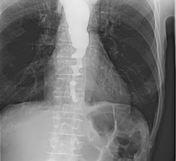Presentation
Dysphagia in an elderly patient with Parkinson's disease.
Patient Data





There are reduced primary contractions and tertiary contractions in the lower oesophagus. Mild dilatation of the upper oesophagus is seen as poor relaxation of the lower oesophagal sphincter. Contrast is seen within the stomach in delayed images.
Case Discussion
Presbyoesophagus is described in elderly patients presenting with dysphagia or non-cardiac chest pain. Impaired reflex arc and reduced sensitivity are thought to be the pathology resulting in reduced primary contractions and impaired sphincter relaxation. Non-propulsive (tertiary) contractions are usually seen in the lower oesophagus.




 Unable to process the form. Check for errors and try again.
Unable to process the form. Check for errors and try again.